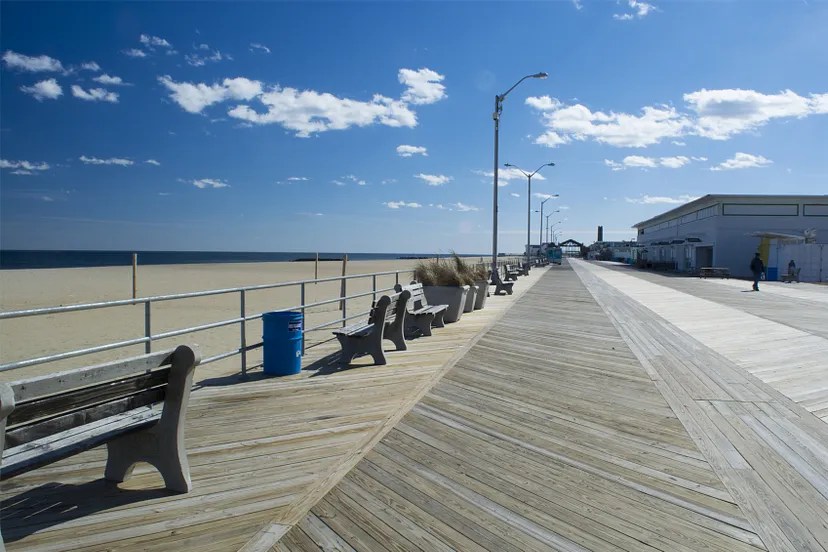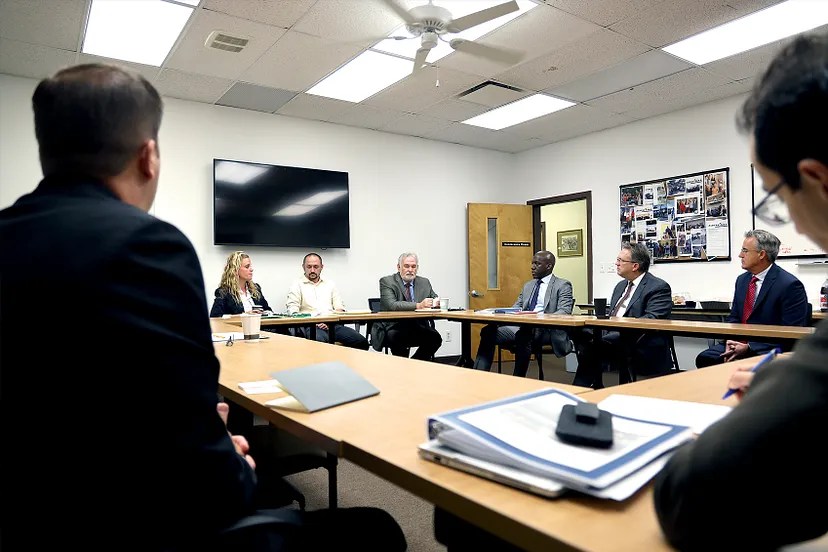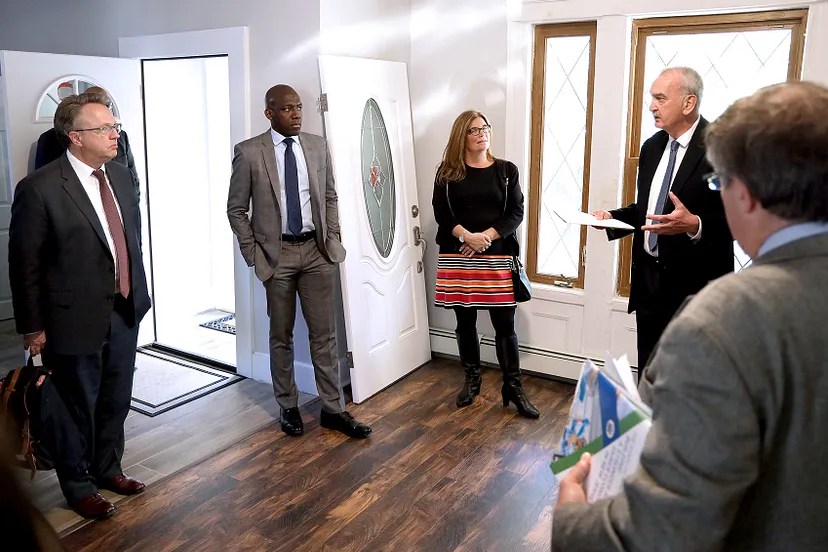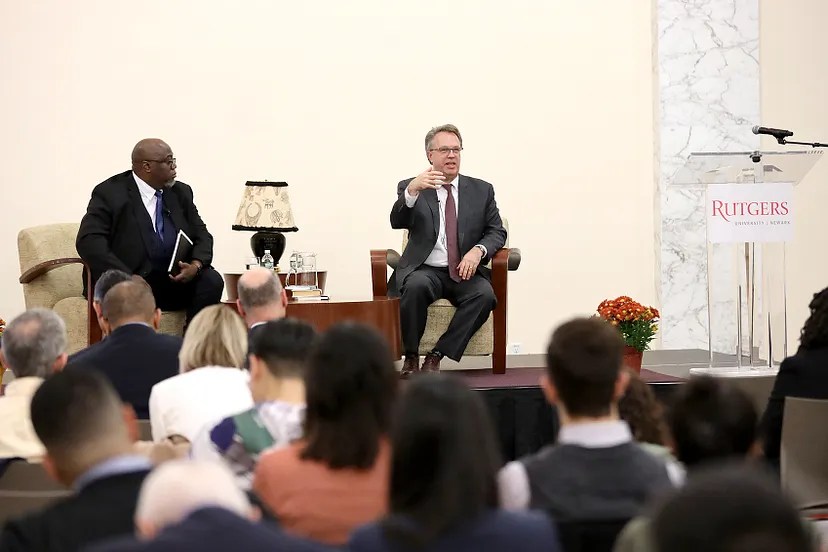
In his final regional visit of 2019, President Williams traveled to Asbury Park, Trenton, and Newark, New Jersey, where he met with community and business leaders, local elected officials, and statewide agency heads. New Jersey is the nation’s most urban and densely populated state, and is among its most wealthy and diverse — factors that loomed large during the daylong visit. Topics of discussion included housing affordability, the intersection between workforce development and higher education, the significance of anchor institutions, and strategies for addressing gentrification.
Affordable Housing
The day began in Asbury Park, a small seaside community famous for its beachfront boardwalk and variety of entertainment options. The city, home to about 16,000 year-round residents, has been experiencing an economic and cultural revival since the early 2000s. Like other areas undergoing revitalization, Asbury Park faces the common challenge of balancing rising housing costs with affordability for long-term residents. These long-term residents include the musicians and artists who helped burnish the city’s reputation as a vibrant, venerated destination. Local stakeholders pointed out that there is affordable housing in Asbury Park, but demand continues to exceed supply.

Another challenge in the community is the rise of short-term rentals, or housing rentals for periods of fewer than 30 days. This trend has reduced homeownership and removed stock from the long-term rental market. Some critics say it leads to “dead zones,” or areas with empty houses in the off-season. To preserve long-term rental housing and minimize detrimental impacts on the community, Asbury Park has restricted short-term rentals to owner-occupied primary properties. This means that, in order to rent out a property on a short-term basis, the owner must also live there as his or her primary residence. Further, each property owner must register with local officials, maintain insurance, and undergo an annual inspection for compliance with fire safety regulations and property maintenance codes.

In Newark, where affordable housing is also a challenge, President Williams visited Family Village, a collection of scattered-site homes being developed by New Jersey Community Capital, the Robert Wood Johnson Foundation, RWJBarnabas Health, and others in the city’s South Ward. These organizations are rehabilitating more than 50 abandoned properties to create more than 100 safe, affordable homes for low- and moderate-income families. RWJBarnabas Health has invested $1 million in the program, marking the first-ever direct investment by a hospital system in housing redevelopment in the state.
This is significant and part of a growing recognition of the critical role housing plays in the health of individuals and their communities. A growing body of evidence shows that individuals who are unable to meet their basic needs, including permanent housing, are less likely or able to have medical issues addressed or pursue preventative care, in addition to the physical and psychological toll caused by housing insecurity. Consistent with this focus on health, the Family Village housing development initiative includes a healthy-eating component. Newark Beth Israel, a part of RWJBarnabas Health, has invested in a community garden that will provide fresh fruit and vegetables to local residents, including those from Family Village.
Higher Education and Workforce Development
In Trenton, President Williams heard from representatives of New Jersey’s Economic Development Authority, Labor and Workforce Development Department, Office of Higher Education, and Rutgers University’s John J. Heldrich Center for Workforce Development about efforts to align the state’s workforce with its economic development programs. These efforts include collaborating with New Jersey’s higher education institutions, developing talent pipelines, and supporting emerging industries.

On the education front, New Jersey is making college degrees more accessible through the Community College Opportunity Grant, a program available to students with an annual family income of less than $65,000. Qualifying students can attend certain New Jersey community colleges tuition-free, and officials expect the initiative to help narrow the state’s college attainment gaps by race and income. Research shows that, in 2017, the educational attainment rate was 76% for Asian and Pacific Islanders, 54% for whites, 32% for African-Americans, and 24% for Hispanic/Latinx.
Efforts to engage working adults in higher education by helping them return to college or enroll for the first time can have significant benefits. Meeting participants noted that helping workers focus on so-called “stackable credentials” — a term used to describe the accumulation of degrees, abilities, and knowledge across different career stages — can help New Jersey build and maintain its talent pipeline. With this in mind, officials are implementing strategies to encourage workers to develop their skills, such as providing opportunities to obtain course credits for work experience and reducing costs and the amount of time required for experienced workers to earn certificates or degrees.
Employers play a role as well. Many New Jersey businesses are working to expand the skilled labor force by offering internship and apprenticeship programs that give students a chance to earn money and gain on-the-job skills while in school. When fewer jobs were available during the recession, employers were able to require credentials or degrees for positions where those capabilities were not necessary. This trend has since shifted as labor markets have tightened. New Jersey government officials are working to encourage more accurate matching of educational credentials to job requirements, which in turn can provide employers with larger applicant pools.
Further, as one of the largest purchasers of construction services in New Jersey, the state government is using its influence to incentivize employer participation in workforce development programs. Contractors who bid or work on public construction projects in New Jersey have been required to register with New Jersey’s Labor and Workforce Development Department since 2000. In May 2019, New Jersey began requiring all public contract workers to certify that they participate in approved apprenticeship programs. The proposed regulations provide a grace period through April 30, 2020 for contractor compliance with apprenticeship program requirements — so the impacts of these regulations are still to be determined. State leaders would like to expand this requirement for public contract bids for all industry sectors.
Anchor Institutions
One idea that surfaced throughout the day was the importance of anchor institutions, or businesses, hospitals, universities, and other organizations “that persist in their communities over generations even in the face of substantial capital flight, serving as social glue, economic engines, or both,” as Rutgers University puts it.
Newark is home to several such institutions, including Rutgers Newark, Prudential Financial, and RWJBarnabas. We met with representatives from several of these institutions during a stop at Prudential, a company with a 140-year history in Newark.
This meeting, which included leadership from the City of Newark and the Newark Alliance, focused on advancing equitable and inclusive economic development strategies in the city. Meeting participants described the “Hire. Buy. Live. Newark” partnership, which aims to strengthen the city’s economy through employment, procurement, and residential strategies. Within this partnership, Newark 2020 focuses on closing the unemployment gap between Newark and New Jersey by connecting unemployed Newark residents to jobs through a consortium of firms.
Efforts are also underway to increase local procurement. The Newark Alliance curates a list of small businesses, many of which have narrowly missed winning contracts to supply goods and services to local businesses. Through the Newark Alliance, procurement officers from local corporations train small business owners on ways to develop more competitive contract bids. The City of Newark also helps small businesses with required paperwork and compliance.
Addressing Gentrification
Discussions about the challenges unearthed by “Hire. Buy. Live” segued into conversations about gentrification. While Newark has not yet experienced much gentrification, meeting participants explained that because change often comes quickly, it is important to develop a skilled local workforce and healthy small businesses to mitigate displacement.

President Williams discussed these ideas in an interview following the regional visit. “I think the longer-term strategy is, think about how to create greater organic economic strength in those communities at risk of gentrification, which we heard about a lot in Newark, which is really building a strong local economy for people who actually live here,” he said. “And that’s about workforce development, education, the economic development, trying to do all that before suddenly there’s a wave of people moving in or employers moving in and helping people who are residents to have more skills, helping them with affordable housing, helping them today so the community is stronger, so if there is gentrification the community is on a stronger foundation.”
See Also
For more information on the New York Fed’s regional visits and what we heard on earlier trips, view our posts on Puerto Rico and the US Virgin Islands, Manhattan, and Albany and the Hudson Valley.
This article was originally published by the New York Fed on Medium.
The views expressed in this article are those of the contributing authors and do not necessarily reflect the position of the New York Fed or the Federal Reserve System.










